How to spot scams like "You Have Received A Secure Message"
Phishing/ScamAlso Known As: You Have Received A Secure Message phishing campaign
Get free scan and check if your device is infected.
Remove it nowTo use full-featured product, you have to purchase a license for Combo Cleaner. Seven days free trial available. Combo Cleaner is owned and operated by RCS LT, the parent company of PCRisk.com.
What is "You Have Received A Secure Message"?
Upon analyzing this email, our team has determined its intention to deceive recipients into disclosing personal information. Scammers behind this message seek to lure victims into providing sensitive data through a deceptive attachment. These types of emails are known as phishing emails.
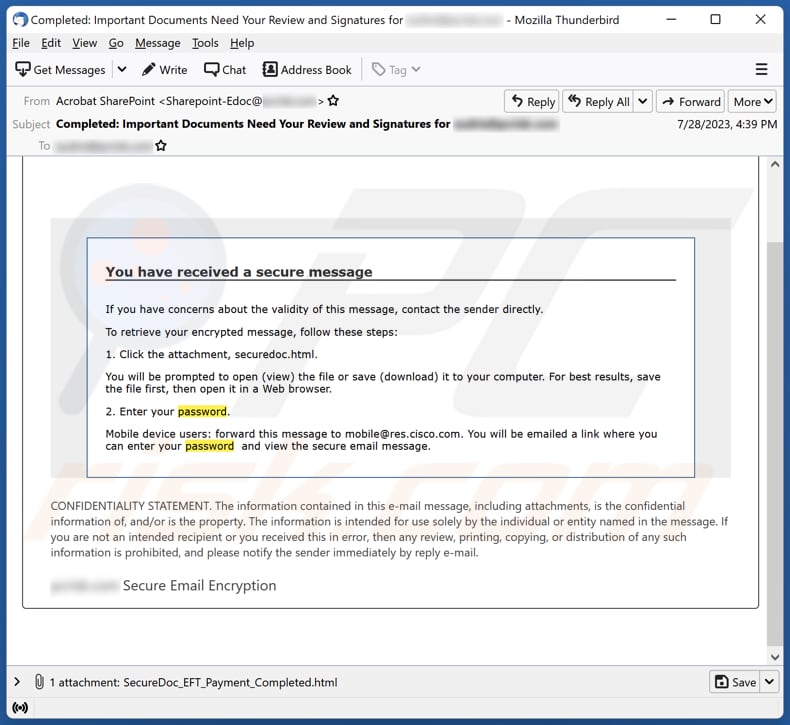
More about the "You Have Received A Secure Message" scam email
This phishing email appears to notify recipients that they have received a secure message. It instructs recipients to retrieve the encrypted message by clicking the attachment, "securedoc.html". The email also prompts recipients to enter their password after opening the attachment.
For mobile device users, the email instructs them to forward the message to mobile@res.cisco.com to receive a link where they can enter their password and view the secure email message. Also, this email has a file named "SecureDoc_EFT_Payment_Completed.html" (its name may vary) attached to it.
After opening the attachment, users are presented with a counterfeit SharePoint sign-in page that requests their email account login credentials (email address and password). Entering the requested information on that page results in providing it to scammers.
With stolen email account login credentials, scammers can access the victim's email account, potentially compromising sensitive personal and financial information. Scammers can use the accessed accounts to send phishing emails or spread malware to the victim's contacts, amplifying the reach of their scams.
Also, they may attempt to reset passwords for other online accounts associated with the same email address, leading to unauthorized access to multiple accounts. Moreover, scammers can use the email account for identity theft. Thus, it is strongly recommended not to trust suspicious emails or provide personal information on websites opened through them.
| Name | You Have Received A Secure Message Email Scam |
| Threat Type | Phishing, Scam, Social Engineering, Fraud |
| Fake Claim | You have received a secure message |
| Attachment | SecureDoc_EFT_Payment_Completed.html (its name may vary) |
| Detection Names (Attachment) | Avast (HTML:Phishing-CQY [Phish]), Combo Cleaner (Trojan.GenericKD.68407318), ESET-NOD32 (HTML/Phishing.Agent.DTT), Ikarus (Phishing.HTML.Doc), VIPRE (Trojan.GenericKD.68407318), Full List Of Detections (VirusTotal) |
| Disguise | Letter regarding a received secure message |
| Symptoms | Unauthorized online purchases, changed online account passwords, identity theft, illegal access of the computer. |
| Distribution methods | Deceptive emails, rogue online pop-up ads, search engine poisoning techniques, misspelled domains. |
| Damage | Loss of sensitive private information, monetary loss, identity theft. |
| Malware Removal (Windows) |
To eliminate possible malware infections, scan your computer with legitimate antivirus software. Our security researchers recommend using Combo Cleaner. Download Combo CleanerTo use full-featured product, you have to purchase a license for Combo Cleaner. 7 days free trial available. Combo Cleaner is owned and operated by RCS LT, the parent company of PCRisk.com. |
Similar scam emails in general
Phishing emails often claim to be from a reputable organization or service, such as a bank, government agency, or well-known company, to appear legitimate. They use urgent or alarming language to develop a feeling of urgency, pushing recipients to take quick action without thinking critically.
As a rule, they contain suspicious attachments or links that lead to phishing websites or malware downloads. Examples of similar emails are "Server Update Notice", "A File Was Shared With You Via Dropbox", and "DHL SHIPMENT REMINDER".
How do spam campaigns infect computers?
Emails used to distribute malware have infectious files attached to them or contain links designed to open malicious pages. These files can include various formats like documents (e.g., Microsoft Office, Microsoft OneNote, PDF), executables (.exe, .run), archives (ZIP, RAR), JavaScript, and more.
When a user executes, runs, or opens a malicious file, it initiates the infection process. However, certain formats may necessitate additional interaction to initiate the download or installation of malware. For instance, Microsoft Office files may require users to enable macro commands for the malware to take effect.
How to avoid installation of malware?
Be cautious with email attachments and links, especially when emails are irrelevant and from unknown or suspicious addresses. Refrain from downloading software or files from untrustworthy websites, P2P networks, and similar sources, and only use reputable sources for downloads.
Keep your operating system, software, and antivirus programs up to date to protect against known vulnerabilities. Exercise safe browsing habits, and avoid clicking on dubious ads or links, pop-ups, buttons, and other content.
If you have already opened malicious attachments, we recommend running a scan with Combo Cleaner Antivirus for Windows to automatically eliminate infiltrated malware.
Text presented in the "You Have Received A Secure Message" email letter:
You have received a secure message
If you have concerns about the validity of this message, contact the sender directly.
To retrieve your encrypted message, follow these steps:
1. Click the attachment, securedoc.html.
You will be prompted to open (view) the file or save (download) it to your computer. For best results, save the file first, then open it in a Web browser.
2. Enter your password.
Mobile device users: forward this message to mobile@res.cisco.com. You will be emailed a link where you can enter your password and view the secure email message.
Screenshot of the attachment used to steal login credentials:
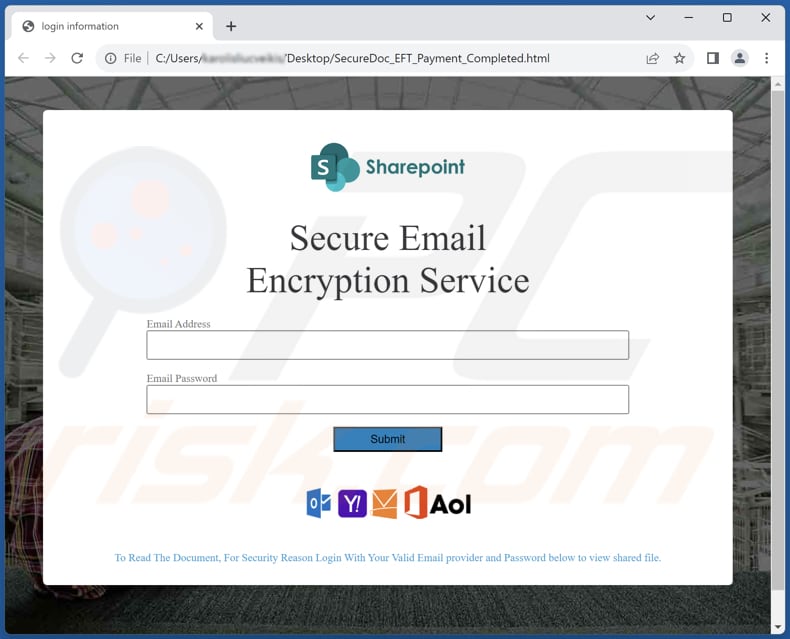
Another example of secure message-themed spam email promoting a phishing site:
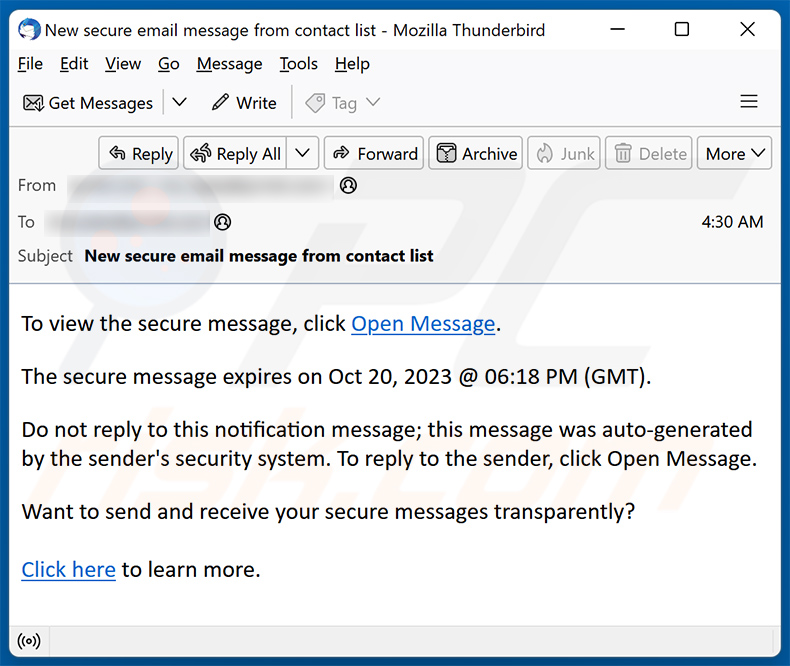
Text presented within:
Subject: New secure email message from contact list
To view the secure message, click Open Message.
The secure message expires on Oct 20, 2023 @ 06:18 PM (GMT).
Do not reply to this notification message; this message was auto-generated by the sender's security system. To reply to the sender, click Open Message.
Want to send and receive your secure messages transparently?
Click here to learn more.
Another example of an email from "You Have Received A Secure Message" spam campaign:
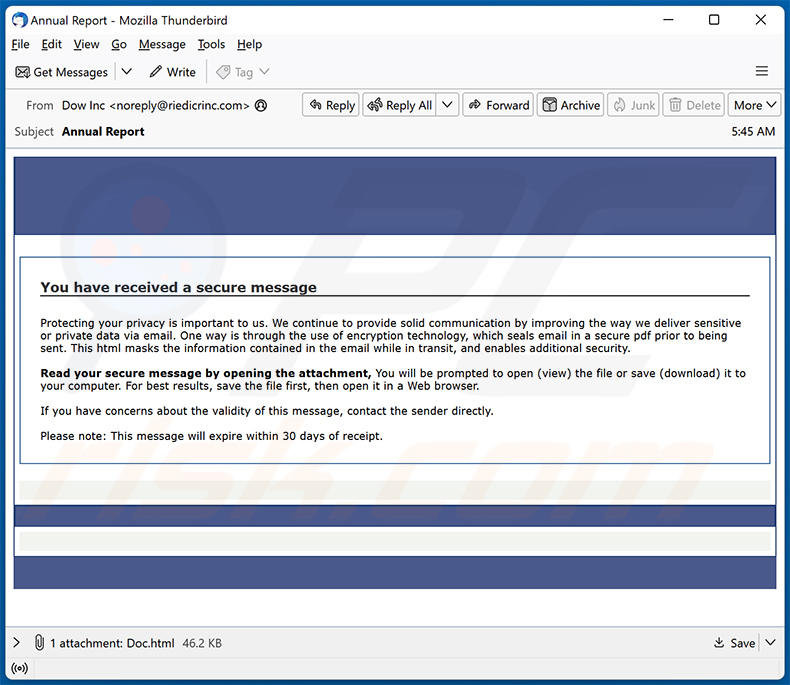
Text presented within:
Subject: Annual Report
You have received a secure message
Protecting your privacy is important to us. We continue to provide solid communication by improving the way we deliver sensitive or private data via email. One way is through the use of encryption technology, which seals email in a secure pdf prior to being sent. This html masks the information contained in the email while in transit, and enables additional security.Read your secure message by opening the attachment, You will be prompted to open (view) the file or save (download) it to your computer. For best results, save the file first, then open it in a Web browser.
If you have concerns about the validity of this message, contact the sender directly.
Please note: This message will expire within 30 days of receipt.
Screenshot of the attached HTML document used for phishing purposes:
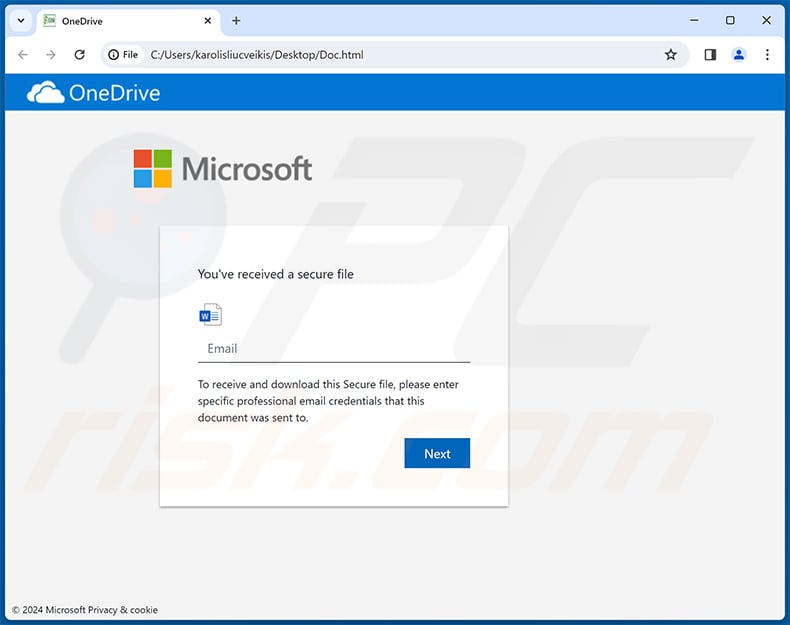
Instant automatic malware removal:
Manual threat removal might be a lengthy and complicated process that requires advanced IT skills. Combo Cleaner is a professional automatic malware removal tool that is recommended to get rid of malware. Download it by clicking the button below:
DOWNLOAD Combo CleanerBy downloading any software listed on this website you agree to our Privacy Policy and Terms of Use. To use full-featured product, you have to purchase a license for Combo Cleaner. 7 days free trial available. Combo Cleaner is owned and operated by RCS LT, the parent company of PCRisk.com.
Quick menu:
- What is You Have Received A Secure Message phishing campaign?
- Types of malicious emails.
- How to spot a malicious email?
- What to do if you fell for an email scam?
Types of malicious emails:
![]() Phishing Emails
Phishing Emails
Most commonly, cybercriminals use deceptive emails to trick Internet users into giving away their sensitive private information, for example, login information for various online services, email accounts, or online banking information.
Such attacks are called phishing. In a phishing attack, cybercriminals usually send an email message with some popular service logo (for example, Microsoft, DHL, Amazon, Netflix), create urgency (wrong shipping address, expired password, etc.), and place a link which they hope their potential victims will click on.
After clicking the link presented in such email message, victims are redirected to a fake website that looks identical or extremely similar to the original one. Victims are then asked to enter their password, credit card details, or some other information that gets stolen by cybercriminals.
![]() Emails with Malicious Attachments
Emails with Malicious Attachments
Another popular attack vector is email spam with malicious attachments that infect users' computers with malware. Malicious attachments usually carry trojans that are capable of stealing passwords, banking information, and other sensitive information.
In such attacks, cybercriminals' main goal is to trick their potential victims into opening an infected email attachment. To achieve this goal, email messages usually talk about recently received invoices, faxes, or voice messages.
If a potential victim falls for the lure and opens the attachment, their computers get infected, and cybercriminals can collect a lot of sensitive information.
While it's a more complicated method to steal personal information (spam filters and antivirus programs usually detect such attempts), if successful, cybercriminals can get a much wider array of data and can collect information for a long period of time.
![]() Sextortion Emails
Sextortion Emails
This is a type of phishing. In this case, users receive an email claiming that a cybercriminal could access the webcam of the potential victim and has a video recording of one's masturbation.
To get rid of the video, victims are asked to pay a ransom (usually using Bitcoin or another cryptocurrency). Nevertheless, all of these claims are false - users who receive such emails should ignore and delete them.
How to spot a malicious email?
While cyber criminals try to make their lure emails look trustworthy, here are some things that you should look for when trying to spot a phishing email:
- Check the sender's ("from") email address: Hover your mouse over the "from" address and check if it's legitimate. For example, if you received an email from Microsoft, be sure to check if the email address is @microsoft.com and not something suspicious like @m1crosoft.com, @microsfot.com, @account-security-noreply.com, etc.
- Check for generic greetings: If the greeting in the email is "Dear user", "Dear @youremail.com", "Dear valued customer", this should raise suspiciousness. Most commonly, companies call you by your name. Lack of this information could signal a phishing attempt.
- Check the links in the email: Hover your mouse over the link presented in the email, if the link that appears seems suspicious, don't click it. For example, if you received an email from Microsoft and the link in the email shows that it will go to firebasestorage.googleapis.com/v0... you shouldn't trust it. It's best not to click any links in the emails but to visit the company website that sent you the email in the first place.
- Don't blindly trust email attachments: Most commonly, legitimate companies will ask you to log in to their website and to view any documents there; if you received an email with an attachment, it's a good idea to scan it with an antivirus application. Infected email attachments are a common attack vector used by cybercriminals.
To minimise the risk of opening phishing and malicious emails we recommend using Combo Cleaner Antivirus for Windows.
Example of a spam email:

What to do if you fell for an email scam?
- If you clicked on a link in a phishing email and entered your password - be sure to change your password as soon as possible. Usually, cybercriminals collect stolen credentials and then sell them to other groups that use them for malicious purposes. If you change your password in a timely manner, there's a chance that criminals won't have enough time to do any damage.
- If you entered your credit card information - contact your bank as soon as possible and explain the situation. There's a good chance that you will need to cancel your compromised credit card and get a new one.
- If you see any signs of identity theft - you should immediately contact the Federal Trade Commission. This institution will collect information about your situation and create a personal recovery plan.
- If you opened a malicious attachment - your computer is probably infected, you should scan it with a reputable antivirus application. For this purpose, we recommend using Combo Cleaner Antivirus for Windows.
- Help other Internet users - report phishing emails to Anti-Phishing Working Group, FBI’s Internet Crime Complaint Center, National Fraud Information Center and U.S. Department of Justice.
Frequently Asked Questions (FAQ)
Why did I receive this email?
Scammers distribute the same emails to numerous recipients, aiming to deceive at least one individual. These spam messages lack personalization and are crafted to target a wide audience indiscriminately.
I have provided my personal information when tricked by this email, what should I do?
In the event that you have unintentionally shared your email address and password with scammers, promptly visit the website of the affected account and change your password. Additionally, if you use the same or similar login credentials for other accounts, ensure to change their passwords too.
I have downloaded and opened a file attached to this email, is my computer infected?
No, the HTML file attached to this email is not designed to infect computers. However, it is important to know that attachments sent by cybercriminals can be malicious.
I have read the email but did not open the attachment, is my computer infected?
Merely opening an email is safe and poses no threat to your system. However, it is essential to be cautious when interacting with links within the email or opening attached files, as these actions can potentially result in system infections.
Will Combo Cleaner remove malware infections that were present in email attachment?
Combo Cleaner possesses the capability to identify and eliminate almost all known malware. Nevertheless, sophisticated malware can be deeply concealed within the system, making a comprehensive system scan necessary to detect and eliminate the malware.
Share:

Tomas Meskauskas
Expert security researcher, professional malware analyst
I am passionate about computer security and technology. I have an experience of over 10 years working in various companies related to computer technical issue solving and Internet security. I have been working as an author and editor for pcrisk.com since 2010. Follow me on Twitter and LinkedIn to stay informed about the latest online security threats.
PCrisk security portal is brought by a company RCS LT.
Joined forces of security researchers help educate computer users about the latest online security threats. More information about the company RCS LT.
Our malware removal guides are free. However, if you want to support us you can send us a donation.
DonatePCrisk security portal is brought by a company RCS LT.
Joined forces of security researchers help educate computer users about the latest online security threats. More information about the company RCS LT.
Our malware removal guides are free. However, if you want to support us you can send us a donation.
Donate
▼ Show Discussion